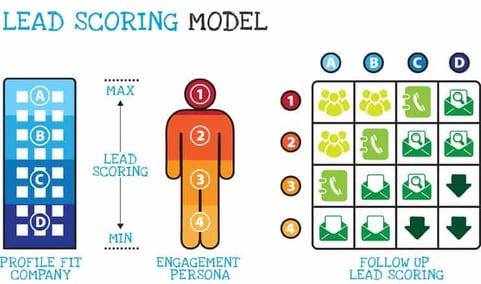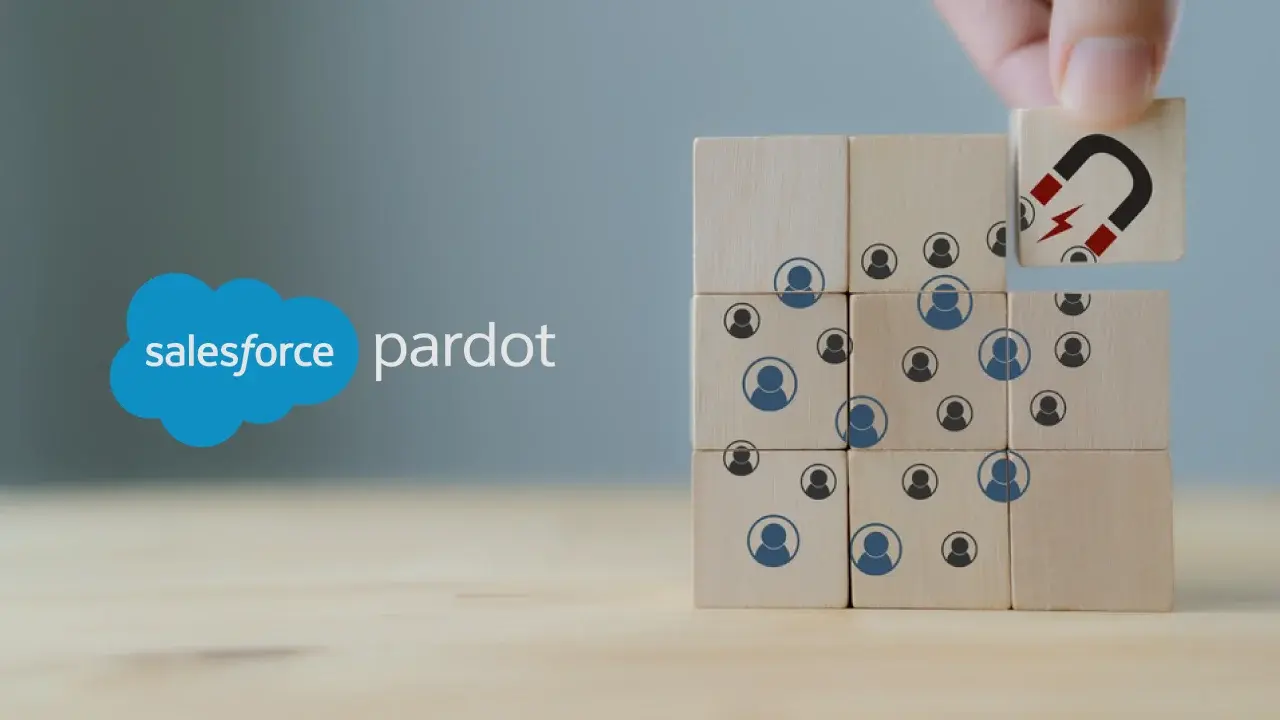.webp?width=915&height=514&name=CMOs%20NOT%20Using%20Lead%20Scoring%20Properly%20-%20Blog%20Image%20(1).webp)
How is lead scoring used?
Lead scoring assigns a lead a numerical value centered on the actions they take and their demographics.
For example, when a brand has too many leads flowing in, it can be almost impossible for the sales team to turn those leads into closed deals. So instead, marketers use lead scoring to determine which leads are worth going after based on the prospect’s likelihood of purchasing the product or service.
Read more on the importance of lead scoring in identifying the best quality leads!
This way, the sales team can sell without having to gauge if the prospect is ready to buy. Thus, saving a company money, time, and resources.

Source: engagebay
How is a lead assigned their score?
A lead is assigned a numerical value based on their demographics and engagement with a brand.
A marketer’s goal is to measure how well their product meets their audience’s needs. If lead scoring is done right, the higher the lead score, the higher the likelihood of closing a deal with that lead. Add points to a lead that exhibits the buying behavior and target demographics your brand is going after. On the contrary, subtract points if the lead isn’t or stops displaying buying cues.
How does the buyer’s journey relate to lead scoring?
The buyer’s journey consists of three phases: prospects at the top of the funnel, the middle of the funnel, and at the bottom of the funnel.
Collecting leads can sometimes be compared to casting a wide net into the sea and catching tons of different fish species. If you’re only looking to hook a certain kind of fish, you’re going to need to let some fish go. By scoring your leads, you can narrow down your lead pool.
The top-of-the-funnel leads are at the awareness stage in their buying journey. They are barely getting to know your brand. The leads in the middle of the funnel are in the consideration stage. They’ve gotten to know your brand enough so that they’re starting to consider it as a potential satisfaction to their needs.
Finally, the leads at the bottom of the funnel are at the decision stage, just one nudge away from buying from you or walking away. Marketers commonly work from top to middle of the funnel before passing the qualified leads over to the sales team. The sales team then works at the bottom of the funnel to close the deals.
 Source: Propeller CRM
Source: Propeller CRM
Why marketers should be working together with sales to develop a definition of ICP, MQL & SQL
Both sales and marketing teams should work together to develop a detailed plan for how they’re going to operate with each stage of the buyer’s journey.
There needs to be a consensus across both teams as to what constitutes an ICP. Your brand’s Ideal Customer Persona is the framework for what kind of leads to go after. If you’re a B2B brand, you might look at demographic factors like company size, location, and industry. If you’re a B2C brand, you might look at a larger range of factors like age, gender, race, income, etc.
From there, sales and marketing need to evaluate what makes up a Marketing Qualified Lead, what makes up a Sales Qualified Lead, and how they can transition from MQL to SQL as smoothly as possible.
A marketer assigns MQL and SQL a numerical value that is used to mark the transition between buying phases. The score is the result of the prospect’s demographics and purchase behavior they exhibited toward your brand.
Source: Digital Uncovered: How to Create a Lead Scoring Model
Here’s a cool lead scoring model to gauge whether your prospect is likely to buy from you. The higher the demographic fit and the higher the engagement fit means a higher chance of a sale.
Common mistakes that CMO's make when using a lead scoring model?
Not checking in with your sales team often
Scheduling regular meetings between marketing and sales teams ensure everyone is on track to win more closed deals. Without input from the sales team, marketing is left wondering why some prospects purchased the services and why some walked away when they were so close to buying. According to Hubspot, some good questions to ask your sales team can be:
- What do our consumer’s demographics look like?
- What are some FAQs leads have about our brand?
- During your sales discovery call with a prospect, is there website content that prospects keep referring back to?
- Finally, think about the last five leads that decided not to purchase. What did they have in common?
Having frequent conversations like this with your sales team can help both of you pinpoint if there’s a mistake in your buyer funnel that needs fixing. That is if you’re having trouble converting your cold leads into MQLs, MQLs into SQLs, or SQLs into closed deals. These questions also help to optimize your Ideal Customer Persona, given that ICP’s change often.
If you are looking for information on how to improve lead quality, click on this link.
Not updating scores frequently
The scores you assign your leads should be updated on a semi-frequent basis.
You can decide on the timeframe of your choosing, but don’t wait so long that the action is no longer fresh in the prospect’s mind. For example, say your prospect has visited your website six times in the past week and just subscribed to your newsletter three days ago. These actions are still perfectly relevant to your prospect and show their interest in your brand.
On the other hand, if it’s been two months since they’ve last visited your webpage or opened your emails, then it might be time to update your lead score for that individual. If you notice a prospect suddenly stops engaging with your content as they once did, you should subtract points from their lead score or even reevaluate their lead score altogether.
Focusing too much on ‘vanity metrics’
Vanity metrics are benchmarks like follower count, likes, comments, etc.
While these benchmarks seem like an excellent way to gauge the popularity of your brand by themselves, they don’t translate to a high return on investment. For example, say you’re a content creator with 10,000 followers on social media, sure gaining your first 10k followers must feel good, and it’s no small achievement. However, not all of those 10k followers are guaranteed to turn into sales.
A better way of gauging a prospect’s readiness to buy would be focusing on any gated content they may have downloaded, like white papers or e-books. Gated content means they took the extra step of inputting their personal information for your valuable content.
According to EMarketeer, other vanity metrics like open email rates and webpage views don’t amount to many points on their own. However, if your prospect opens all emails you send and visits your website frequently, you might consider granting them a slightly higher score. When looking at the prospect’s activity as a whole, it may mean they’re interested enough in your brand and ready to purchase your services.
A complicated lead scoring model
EMarketer suggests capping your lead score at 100 points. 0-50 points is a cold lead, 50 - 79 is an MQL, and 80 + is SQL. Of course, lead scoring rules are flexible and should adapt to each brand, so feel free to experiment with scores. An example of a good scoring model would be,
A customer who:
- Meets the target demographics for your brand product like company size, industry, and job title (+30)
- Has opened all eight emails you’ve sent, visited your webpage six times in the last week, and has viewed your website’s pricing page. (+21)
- Has attended all 3 of your webinars (+21)
- Has downloaded your gated content (+10 points)
At this point, the above prospect would be ready to be handed off to sales given how much engagement they’ve had with your brand and the target qualities they possess. Assign a specific number of points to every action.
For example, say, a prospect visited your webpage only to apply for a job. Right away, you should have an idea that they’re probably not the right people to market to.
Another example would be a student downloading your gated content for research purposes. Neither of the prospects in these scenarios would probably rank high on your list of potential buyers. So instead of subtracting points from their scores, it would be best just to discard them altogether and stick only to leads that fit your engagement and demographic traits.
Being too generous when assigning points to a lead
The point of using a lead scoring system is to prioritize leads that are most likely to buy from you. When using a lead scoring system, it’s essential to be meticulous when assigning scores.
According to BlendB2B, avoid being too generous when assigning points to a lead since you can risk bloating these scores and therefore pass unqualified leads to your sales team. Instead, assign each action an appropriate score that measures its importance accurately.
Take the above example, 10 points are given to each demographic trait, and 7 points are given to each action. Target demographic traits are given more importance and are therefore weighed more. Demographics are more critical because they provide context to the prospect’s buying behavior.
For example, you’re a B2B company selling your services to midsize companies on the East Coast. Since you’re going after another business, you would have to target that company’s decision-maker like their CEO.
If you notice you’re getting traction from individuals that work in your target industry and have the job titles you’re looking to target, then you’ve potentially hit the jackpot!
Conversely, if you notice you’re getting traction from individuals that are merely using your website for research purposes, like students, that engagement score no longer has value because the target demographics aren’t being met.
For example, students aren’t likely to buy from you, so you know you aren’t getting any monetary value out of their engagement with your brand. In this case, you would assign more points to the prospects that are within your target industry and fewer points to those that aren’t.
Parting Words
In conclusion, If your lead pool is too large, consider using lead scoring to narrow down the number of prospects so your sales team can focus on selling to the most qualified prospects.
Marketers, work closely with your sales team when defining lead stages but also during the lead stages themselves. Asking questions about each team’s processes can help fix broken links within the buyer’s funnel to ensure all leads are flowing downward smoothly.
Keep your lead scores simple by only focusing on buying behaviour and demographics. Marketers must carefully assign lead points to ensure only the most interested buyers are handed off to sales.
To all the CMO's out there, avoid all these mistakes in your lead-scoring journey and watch your model fetch great business results!
Looking for professional help with lead scoring? Reach out to Revx Today.
 Dashboards and analytics
Dashboards and analytics



.webp)




